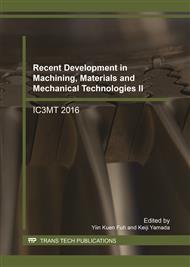[1]
A. Nino, A. Tanaka, S. Sugiyama, H. Taimatsu, Indentation size effect for the hardness of refractory carbides, Mater. Trans. 51 (2010) 1621-1626.
DOI: 10.2320/matertrans.m2010110
Google Scholar
[2]
A. Nino, K. Takahashi, S. Sugiyama, H. Taimatsu, Effects of carbon addition on microstructures and mechanical properties of binderless tungsten carbide, Mater. Trans. 53 (2012) 1475-1480.
DOI: 10.2320/matertrans.m2012148
Google Scholar
[3]
J. Zhao, T. Holland, Unuvar C, Z. A. Munir, Sparking plasma sintering of nanometric tungsten carbide, Int. J. Refract. Met. Hard Mater. 27 (2009) 130-139.
DOI: 10.1016/j.ijrmhm.2008.06.004
Google Scholar
[4]
S. G. Huang, K. Vanmeensel, O. Van der Biest, J. Vleugels, Binderless WC and WC–VC materials obtained by pulsed electric current sintering, Int. J. Refract. Met. Hard Mater. 26 (2008) 41-47.
DOI: 10.1016/j.ijrmhm.2007.01.002
Google Scholar
[5]
H. C. Kim, J. K. Yoon, J. M. Doh, I. Y. Ko, I. J. Shon, Rapid sintering process and mechanical properties of binderless ultra fine tungsten carbide, Mat. Sci. Eng. A 435-436 (2006) 717-724.
DOI: 10.1016/j.msea.2006.07.127
Google Scholar
[6]
H. C. Lee, J. Gurland, Hardness and deformation of cemented tungsten carbide, Mat. Sci. Eng. 33 (1978) 125-133.
DOI: 10.1016/0025-5416(78)90163-5
Google Scholar
[7]
K. Hayashi, Y. Fukue, H. Suzuki, Effects of addition carbides on the grain size of WC–Co alloy, J. Jpn. Soc. Powder Powder Metall. 19 (1972) 67-71.
DOI: 10.2497/jjspm.19.67
Google Scholar
[8]
H. Taimatsu, S. Sugiyama, M. Komatsu, Effects of Cr3C2 and V8C7 on the microstructure and mechanical properties of WC-SiC whisker ceramics, Mater. Trans. 50 (2009) 2435-2440.
DOI: 10.2320/matertrans.m2009169
Google Scholar
[9]
S. Imasato, K. Tokumoto, T. Kitada, S. Sakaguchi, Properties of ultra-fine grain binderless cemented carbide RCCFN, Int. J. Refract. Met. Hard Mater. 13 (1995) 305-312.
DOI: 10.1016/0263-4368(95)92676-b
Google Scholar
[10]
J. Poetschke, V. Richter, R. Holke, Influence and effectivity of VC and Cr3C2 grain growth inhibitors on sintering of binderless tungsten carbide, Int. J. Refract. Met. Hard Mater. 31 (2012) 218-223.
DOI: 10.1016/j.ijrmhm.2011.11.006
Google Scholar
[11]
H. Taimatsu, S. Sugiyama, Y. Kodaira, Synthesis of W2C by reactive hot pressing and its mechanical properties, Mater. Trans. 49 (2008) 1256-1261.
DOI: 10.2320/matertrans.mra2007304
Google Scholar
[12]
C. B. Ponton, R. D. Rawlings, Vickers indentation fracture toughness test Part 1 Review of literature and formulation of standardized indentation toughness equations, Mater. Sci. Technol. 5 (1989) 865-872.
DOI: 10.1179/mst.1989.5.9.865
Google Scholar
[13]
A. E. McHale ed., Phase equilibria diagram: phase diagrams for ceramists vol. 10, The American Ceramic Society, Ohio, (1994).
Google Scholar
[14]
A. Nino, Y. Nakaibayashi, S. Sugiyama, H. Taimatsu, Microstructure and mechanical properties of WC-SiC composites, Mater. Trans. 52 (2011) 1641-1645.
DOI: 10.2320/matertrans.m2011045
Google Scholar
[15]
A. Nino, N. Takahashi, S. Sugiyama, H. Taimatsu, Effects of carbide grain growth inhibitors on the microstructures and mechanical properties of WC–SiC–Mo2C hard ceramics, Int. J. Refract. Met. Hard Mater. 43 (2014) 150-156.
DOI: 10.1016/j.ijrmhm.2013.11.016
Google Scholar
[16]
Powder Diffraction Files, JCPDS-International Center for Diffraction Data, Pennsylvania: 1994, No. 25-1047.
Google Scholar
[17]
Powder Diffraction Files, JCPDS-International Center for Diffraction Data, Pennsylvania: 1994, No. 38-1364.
Google Scholar
[18]
Powder Diffraction Files, JCPDS-International Center for Diffraction Data, Pennsylvania: 1994, No. 25-0284.
Google Scholar
[19]
Powder Diffraction Files, JCPDS-International Center for Diffraction Data, Pennsylvania: 1994, No. 35-0776.
Google Scholar
[20]
L. E. Toth, Transition Metal Carbides and Nitrides, Academic, New York, (1971).
Google Scholar
[22]
I. N. Frantsvich, E. A. Zhurakovskii, A. B. Lyashchenko, Elastic constants and characteristics of the electron structure of certain classes of refractory compounds obtained by the metal-powder method, Inorg. Mater. 3 (1967) 6-12.
Google Scholar
[22]
C. Kral, W. Lengauer, D. Rafaja, P. Ettmayer, Critical review on the elastic properties of transition metal carbides, nitrides and carbonitrides, J. Alloy. Compd. 265 (1998) 215-233.
DOI: 10.1016/s0925-8388(97)00297-1
Google Scholar
[23]
A. T. Santhanam, Introduction to the chemistry of transition metal carbides and nitrides, In: Oyama ST, editor, Transition Metal Carbides and Nitrides: Application of Transition Metal Carbides and Nitrides in Industrial Tools, Blackie Acad. And Prof London, (1996).
DOI: 10.1007/978-94-009-1565-7_2
Google Scholar
[24]
P. T. B. Shaffer. Plenum Press Handbook of High Temperature Materials, Materials Index Plenum Press, New York, (1964).
Google Scholar
[25]
V. S. Neshpor, G. V. Samsonov, The brittleness of metallike compound, Fiz. Met. Metalloved. 4 (1957) 181-182.
Google Scholar
[26]
P. Ettmayer, W. Lengauer, Carbides: Transition metal solid-state chemistry. In: Encyclopedia of Inorganic Chemistry, Wiley, New York, (1999) 519-531.
DOI: 10.1002/0470862106.ia034
Google Scholar
[27]
C. K. Jun, P. T. B. Shaffer, J. Less-Common Metals 23 (1971) 367-373.
Google Scholar
[28]
A. P. Miodownik, Young's modulus for carbides of 3d elements (with particular reference to Fe3C), Mater. Sci. Technol. 10 (1994) 190-192.
Google Scholar
[29]
R. W. Rice, C. C. Wu, F. Borchelt, Hardness–grain-size relations in ceramics, J. Am. Ceram. Soc. 77 (1994) 2539-2553.
Google Scholar


